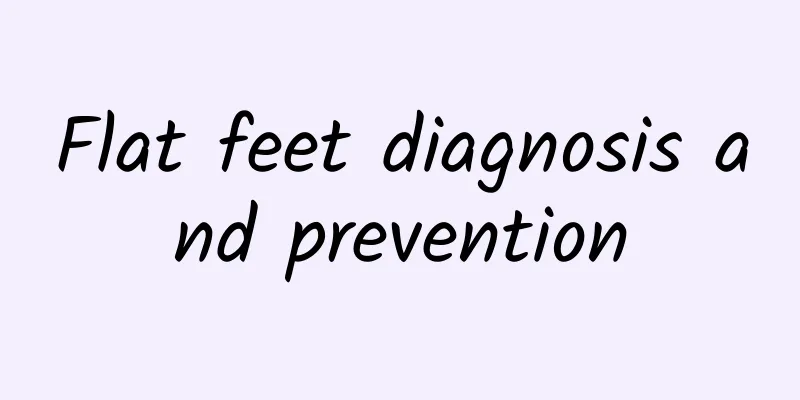Flat feet diagnosis and prevention

|
1. What are flat feet? The arch of the foot is an arched structure composed of the bones, ligaments and muscles of the foot. The three interact with each other to form a whole. Flat feet refer to a low or sunken arch when standing. From the appearance, the sole of the foot appears flat and the arch is close to the ground. 2. Is the height of the arch of the foot congenital or acquired? Generally speaking, flat feet can be caused by either genetic factors or acquired factors. Both genetic factors and acquired factors have a certain influence on the occurrence of flat feet. 1. Genetic factors: Genetic factors play a major role in congenital flat feet. Some studies have shown that flat feet have a certain familial inheritance, and children with a family history of congenital flat feet are more likely to develop congenital flat feet. 2. Acquired factors: Acquired flat feet are mainly related to the following factors: Foot trauma and disease: Trauma, disease or surgery can cause damage to the bones, muscles, nerves and other tissues of the foot, leading to acquired flat feet. Muscle and ligament relaxation: Abnormal collagen metabolism in the body leads to muscle and ligament relaxation, which deforms the arch structure and causes acquired flat feet. Weight gain: Being overweight or obese may cause compression of the arch structure, gradually leading to plantar fasciitis and tenosynovitis, and further developing into acquired flat feet. Aging: With age, muscle strength and ligament relaxation, the arch system gradually weakens, which may also lead to acquired flat feet. Inappropriate shoes: Wearing inappropriate shoes for a long time, such as shoes with too hard or too low soles and lack of arch support, may also lead to acquired flat feet. In summary, flat feet may be caused by genetic factors or acquired factors. Maintaining a healthy lifestyle, such as a proper diet, moderate exercise and wearing suitable shoes, can help prevent and improve flat feet. 3. What harm does flat feet do to health? Flat feet refer to partial or complete collapse of the arch of the foot, with a larger area of the sole contacting the ground and unable to form a normal arch. Flat feet may lead to the following potential hazards and discomforts: Foot pain: Flat feet may cause foot pain, including pain in the sole of the foot, pain in the arch area, pain in the ankle joint, etc. Foot fatigue and discomfort: Flat feet lack normal arch support and can easily cause foot fatigue and discomfort, especially after standing or walking for long periods of time. Foot deformities: Long-standing flat feet may lead to changes in the structure and posture of the foot, such as flattening of the foot and toe deviation. Impact on gait and balance: Flat feet may affect normal gait movement and balance ability, increasing the risk of falls and sprains. Knee, hip and lumbar spine problems: Flat feet can lead to abnormal force transmission in the foot, which may put extra strain on the knees, hip joints and lumbar spine, increasing the risk of injury to these joints and structures. 4. If you have flat feet, how can you exercise in your daily life to reduce the impact of flat feet? Sitting tiptoe: Sit with your legs apart, toes on the ground, and tighten your calf muscles for 5-10 minutes. Toe grabbing paper towel or towel: Sit down and use your toes to lift a paper towel or towel. Repeat 20-30 times. Foot Roller: Sit or stand, and roll forward and backward on the roller with the help of the armrests. Standing foot eversion: Stand with both feet everted, hold for 20-30 seconds each time, repeat and rest Special Tips: Avoid standing for long periods of time, long-distance walking, running, jumping and other strenuous activities, pay attention to controlling your weight and reducing the weight you carry; It is recommended to soak your feet in hot water frequently. You can add Chinese herbal medicine to the hot water to promote blood circulation in the feet and relieve soreness and pain. Flat-foot patients should try to wear flat shoes instead of shoes with heels. Flat shoes can exercise the calf and sole muscles and reduce foot fatigue. You can also wear flat-foot correction shoes or use such insoles to relieve discomfort to a certain extent. 5. When does flat feet require intervention? If flat feet occur with plantar pain, limited movement, or bone deformities on X-ray examinations, surgical intervention may be required. It is recommended that you actively cooperate with the doctor for treatment. |
<<: How to prevent cervical cancer in older women
Recommend
Leucorrhea is like tofu dregs
Women's normal leucorrhea is transparent and ...
What's in a maternity bag for pregnant women?
In the late stages of pregnancy, although pregnan...
What causes less armpit hair during pregnancy?
Everyone has armpit hair, but some people have mo...
Foot bath recipe to warm the uterus
Uterine cold is a problem that many women suffer ...
Discharge like tofu dregs, Chinese medicine treatment method
Do female friends have troubles with gynecologica...
“Among high-protein foods, soybeans rank first and eggs rank eighth” Is it credible?
[This issue's rumor] Recently, a self-media a...
Harm of gynecological Chinese medicine enema
Gynecological diseases are common diseases among ...
Can I exercise a lot during menstruation?
Women will experience some symptoms such as lower...
What is the best medicine for uterine prolapse?
When a patient has uterine prolapse, they usually...
APP's revenue in 2011 was more than twice that of Facebook
On August 6, 2012, the App Store was launched for...
Can I skip rope during menstruation?
Many women will experience physical discomfort du...
What is the best food for women to replenish blood and qi?
Due to special physiological reasons, women often...
What to eat to nourish the stomach when a girl has a bad stomach
The stomach is a very important digestive organ f...
How long does it take to cure fallopian tube obstruction?
Fallopian tube blockage is a common gynecological...
Is it painful to remove polyps?
Physical health is particularly important. A heal...









